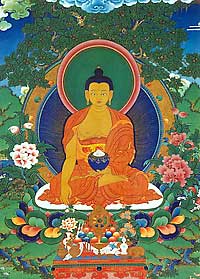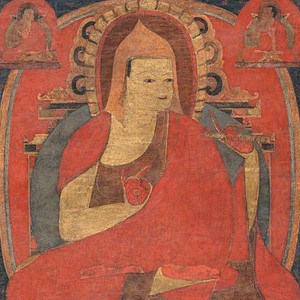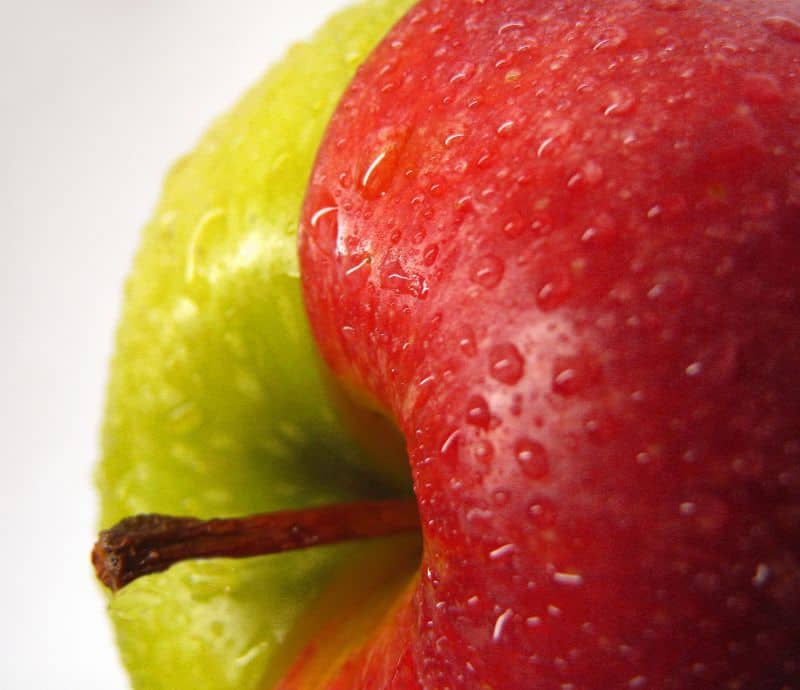Practicing Dharma in daily life

Upon waking up
In the morning when you wake up, visualize the Buddha on the crown of your head and think,
“How fortunate I am that so far I have not died. Again today I have the opportunity to practice the Dharma. I again have the opportunity to take the essence of this precious human life that has so many freedoms and fortunes. This great essence is to practice bodhicitta, the mind that is dedicated to attaining awakening for the benefit of all sentient beings, and to do this by giving up my self-centeredness and by cherishing others. Self-preoccupation is the greatest obstacle to being happy myself and to bringing about the happiness of all sentient beings. So from now on, I will never allow myself to be under the control of the self-centered thought.
Cherishing others is the best means to be happy and successful myself and especially to bring about the happiness desired by all sentient beings. Therefore, from now on, I will never separate from the precious bodhicitta—the loving, compassionate mind that cherishes other sentient beings—for even one moment. I will live my life with kindness, love, compassion, and bodhicitta.”
Then make a sincere request to the Buddha, “Whether I experience happiness or pain, may whatever actions I do with my body, speech and mind always become only the cause to quickly lead mother sentient beings throughout infinite space to awakening.”
Guru Shakyamuni Buddha is extremely pleased with your request. He melts into light, which flows down through your crown to your heart, inspiring and transforming your mind. Think, “I have received all of the Buddha’s qualities—serenity, love, compassion, altruism, friendliness, kindness, wisdom and other wonderful qualities.”
Imagine a small Buddha made of light appears at your heart. Throughout the day, think of the Buddha constantly. In this way, you will become more mindful of what you do, say and think, as you will be aware of the Buddha witnessing it.
Read and contemplate the Eight Verses of Thought Transformation.
By remembering Guru Shakyamuni Buddha, do your daily life actions as follows:
Eating and drinking
Before you eat or drink, think, “I am going to make this food (drink) offering to Guru Shakyamuni Buddha, who is the embodiment of all the Buddhas, Dharma, and Sangha, in order to attain full awakening for the sake of all mother sentient beings.”
Think the food is very pure like sweet nectar that gives great bliss and tastes delicious, similar to what the Buddha experiences. This food is completely beyond the usual ordinary appearance of food. Offer the food with the verses in this book, and imagine that the Buddha at your heart experiences bliss as you eat.
Enjoying sense objects
Whatever sense objects you enjoy during the day—clothes, music, beautiful scenery and so forth—think that you are offering them to Guru Shakyamuni Buddha who is at your heart. In this way, you continuously make offerings to the Buddha, thus creating a great collection of merit. Also, you will become less attached to sense pleasures and will begin to enjoy them with a peaceful mind.
Making offerings on the altar
Think, “I am going to make these offerings in order to attain awakening for the benefit of all suffering mother sentient beings who have been kind to me since beginningless rebirths.”
Consecrate the food, flowers, water, light and so forth that you offer by saying “OM AH HUM” three times.
When you look at the pictures and statues of the Buddhas and holy beings on your altar, think that they are all the spiritual mentors, Buddhas, Dharma and Sangha of the ten directions. Offer to them with this recognition, and imagine that they generate great bliss by receiving your offerings. Offer to the statues of the Buddhas and deities (which represent Buddha’s holy body), to all the scriptures (which represent the Buddha’s holy speech), and to all the stupas (which represent the Buddha’s holy mind) that exist throughout the universe. This is the most skillful way to accumulate merit. In this way, you make offerings to each and every holy object without needing to take even one step or spend even one dollar to travel to those places. By thinking that all the statues, Buddhas, bodhisattvas and so forth are manifestations of the guru, you accumulate the highest merit.
After offering, think, “Whatever happiness and virtue I have created, may all sentient beings receive it, and whatever suffering sentient beings have, may it ripen upon me.”
Then dedicate the merit.
Click here for an explanation of the extensive offering practice.
Working
When you go to work, think, “I must achieve awakening in order to lead each and every sentient being to awakening. Therefore, I am going to offer service for sentient beings by going to work. May whoever comes in contact with the results of my work have a peaceful mind and generate bodhicitta.”
While you are at work, remember the kindness of the other sentient beings who gave you the job and who make it possible for you to earn a living. Thinking in this way helps to avoid generating destructive emotions such as anger at work.
Bathing
Think, “I am going to transform bathing into the cause to attain awakening for the benefit of all sentient beings.”
By thinking in a new way, make your shower or bath a purification practice. One way to think is that the water is very blissful and you are offering it to the Buddha at your heart. Another way is to visualize whichever manifestation of the Buddha you feel a strong connection with (for example, Chenrezig or Tara) above your head and think that the bathing water is flowing from his/her hand. The water is the nature of wisdom, and it is making your mind clear so you can practice the path for the benefit of sentient beings. While you are washing, think that all destructive karmas, sicknesses and interfering forces are washed away by the wisdom realizing emptiness and that you receive all the realizations and qualities of the Buddha.
Sleeping
At the end of the day it is important to purify any destructive actions created during the day. The most powerful method to do this is by means of the four opponent powers:
- Having regret for the negative actions you have done.
- Taking refuge and generating bodhicitta.
- Doing remedial actions, i.e. a purification practice.
- Determining not to do the action again in the future.
Doing these four stops the karmas from multiplying each day, each week, each month. It also purifies the destructive karma accumulated since beginningless time. By cleansing these obstacles, you will have the opportunity to become a Buddha.
Before going to bed, think, “I take refuge until I have awakened in the Buddhas, the Dharma and the Sangha. By the merit I create by engaging in generosity and the other far-reaching practices, may I attain Buddhahood in order to benefit all sentient beings.”
Visualize Guru Vajrasattva on your crown. Light and nectar flow down from his heart into you and purify all destructive karmas and obscurations of yourself and others. While visualizing this, recite Vajrasattva’s mantra:
Om vajrasattva hum. (28x)
Then Vajrasattva says to you, “All of your destructive karmas and obscurations are completely purified. Feel delighted.” Vajrasattva absorbs to your heart and inspires your mind.
May the precious bodhi mind
Not yet born arise and grow.
May that born have no decline,
But increase forever more.
In all my lives, with the Victorious One, Je Tsongkhapa, acting as the actual Mahayana spiritual mentor, may I never turn aside for even an instant from the excellent path praised by the Victorious Ones.
Due to the merit accumulated by myself and others in the past, present and future, may anyone who merely sees, hears, remembers, touches or talks to me be freed in that very instant from all sufferings and abide in happiness forever.
When you go to bed, think, “I am going to practice sleeping yoga in order to become a Buddha for the benefit of all sentient beings.”
Lie down in the lion position, which is how Buddha laid when he passed away: lie on your right side, with your right hand under your cheek. Your left hand is on your left thigh, and your legs are extended. Remember the kindness and sufferings of sentient beings and go to sleep feeling love and compassion towards them. Visualize Guru Shakyamuni Buddha on your pillow, and put your head in his lap. Very gentle light flows from the Buddha into you, and while remembering the Buddha’s awakened qualities with devotion, fall asleep.
Click here for more teachings on practicing Dharma in daily life.
Kyabje Lama Zopa Rinpoche
Kyabje Lama Zopa Rinpoche, one of Venerable Chodron's teachers, was born in Thami, Nepal, in 1946. At the age of three he was recognized as the reincarnation of Sherpa Nyingma yogi, Kunsang Yeshe, the Lawudo Lama. Rinpoche’s Thami home was not far from the Lawudo cave, in the Mount Everest region of Nepal, where his predecessor meditated for the last twenty years of his life. Rinpoche’s own description of his early years may be found in his book, The Door to Satisfaction (Wisdom Publications). At the age of ten, Rinpoche went to Tibet and studied and meditated at Domo Geshe Rinpoche’s monastery near Pagri, until the Chinese occupation of Tibet in 1959 forced him to forsake Tibet for the safety of Bhutan. Rinpoche then went to the Tibetan refugee camp at Buxa Duar, West Bengal, India, where he met Lama Yeshe, who became his closest teacher. The Lamas went to Nepal in 1967, and over the next few years built Kopan and Lawudo Monasteries. In 1971, Rinpoche gave the first of his famous annual lam-rim retreat courses, which continue at Kopan to this day. In 1974, with Lama Yeshe, Rinpoche began traveling the world to teach and establish centers of Dharma. When Lama Yeshe passed away in 1984, Rinpoche took over as spiritual director of the Foundation for the Preservation of the Mahayana Tradition (FPMT), which has continued to flourish under his peerless leadership. More details of Rinpoche’s life and work may be found on the FPMT web site. (Source: lamayeshe.com. Photo by Aikido.)


